The newly rediscovered interest in slushy cocktails has resulted in me being inundated with questions about how to properly operate a slushie machine. And so, as has always been my mission with this website, I’m here to try to help. You see, for the longest time operating a slushy machine was a lengthy experiment every time I attempted it. My process typically looked like this:
- Make a big batch of cocktails.
- Adjust the recipe to taste.
- Pour it into a slushy machine.
- Wait many, many, many hours for it to get cold enough and hope the texture was right, fingers crossed.
- The texture isn’t right. Shit.
- Try adding some more water. Now we need to get it back down to the right temperature. Wait an hour.
- That made it too watery. Try adding some simple syrup. Wait another hour.
- That seems better. But it’s still kinda chunky-looking.
- Add some alcohol. Wait another hour.
- Okay, now it tastes too strong. Maybe if I add a little more simple syrup, a splash of water, and a little juice. Wait an hour.
- That kind of seems to be working, but now I’m a little drunk from tasting this thing ten times.
- Oh, the event is starting in ten minutes.
- Good enough, I guess.
Obviously that’s a lot of steps, and way too much trial and error to make it a feasible thing to do regularly. But there has to be some sort of formula, right? Well, I did some research, and it gets really confusing, really quickly. There are formulas, there are opinions, there are arguments online, and there is a whole lot of puzzling contradictory info.
I talked to bartenders, and they’re even confusing. There are some who claim to be experts, but after some gentle prodding you discover they’re using the trial and error method I was trying to avoid. And finally I found someone who knows what he’s talking about, my good friend Cameron Bogue. You see, Cameron oversees a shit-ton of slushy machines at the massive restaurant group in Canada he works for. And he told me exactly what you need in order make your slushy drink work. Ready?
It needs to be between 13 and 15 Brix.
And that’s pretty much it. Brix is the unit of measurement of sugar in a water solution. One brix is equal to a gram of sucrose per 100 grams of solution. And, of course, there’s a whole lot of other complicated shit that you can read about that goes along with the topic, but as someone who’s going to put a Daiquiri in a slushy machine, all you need to know is that your Daiquiri needs to be between 13 and 15 Brix.
And how do you figure that part out? Easy. First off, go get yourself a portable refractometer. They’re cheap, and they’re actually kind of fun to use. Once you’ve received your one piece of specialty equipment in the mail (uh, yeah, other than the slushy machine, I guess) then you’re ready to whip up a batch of frozen cocktails with no trial-and-error required.
First, figure out your recipe. You can do this by using the methods I outline in Chapter 9 in my book (shameless plug), or you can throw caution to the wind and just do it to taste. I’ve done it both ways for use in slushy machines and it does not matter. The only two things that matter are that the drink taste good, and that the sugar content is between 13 and 15 Brix.
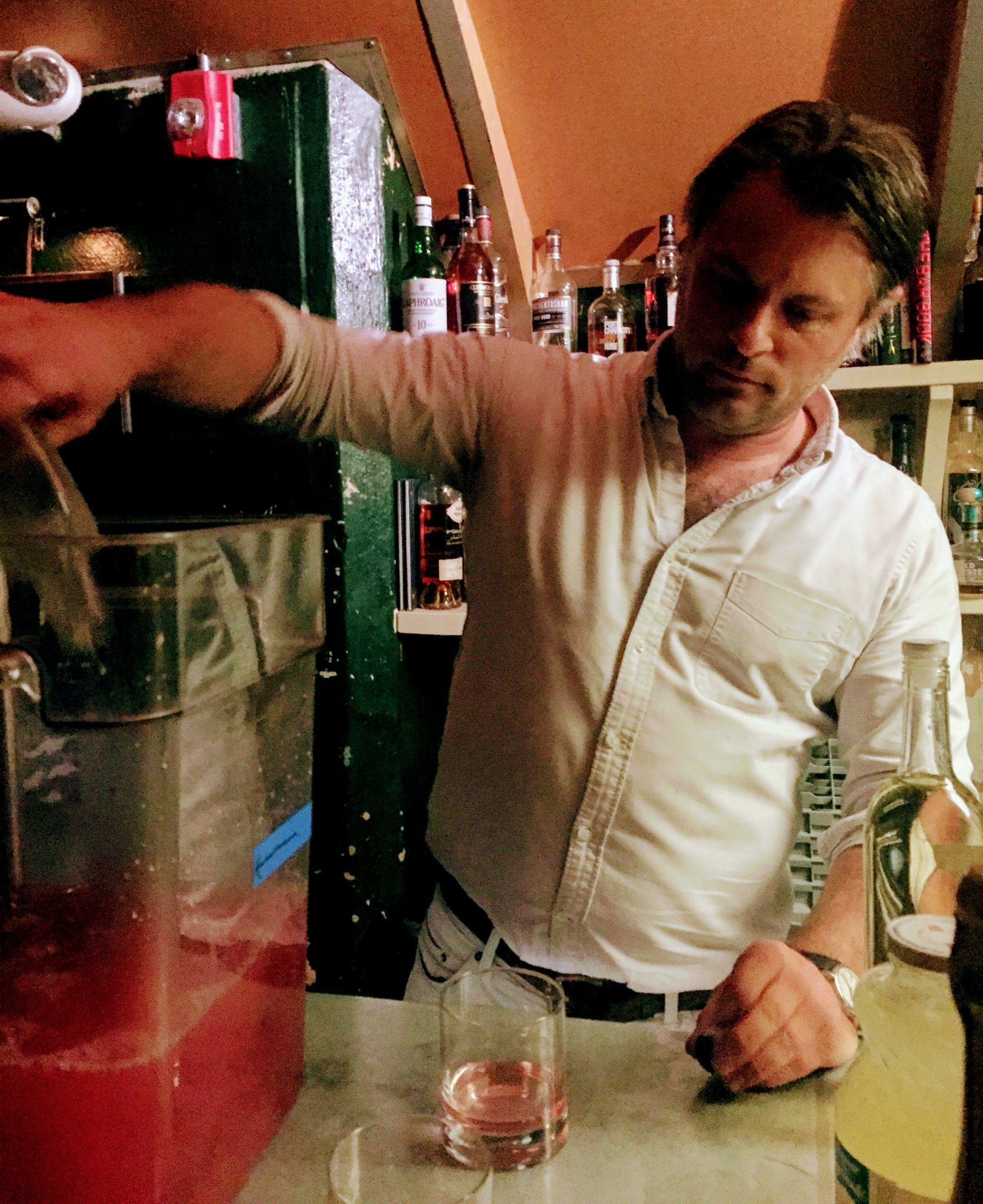
Next, you need to dilute the drink a little. Drinks are pretty rough at full strength, and you’re likely going to have to do it anyway once you start checking the brix, so go ahead and throw some water in there. I like to start with 20%. Want an easy way to do that? Figure out the volume of your cocktail (real easy to do if you’ve got it in a big measuring container) and multiply by .2 – That’s the amount of water you’re gonna want to add.
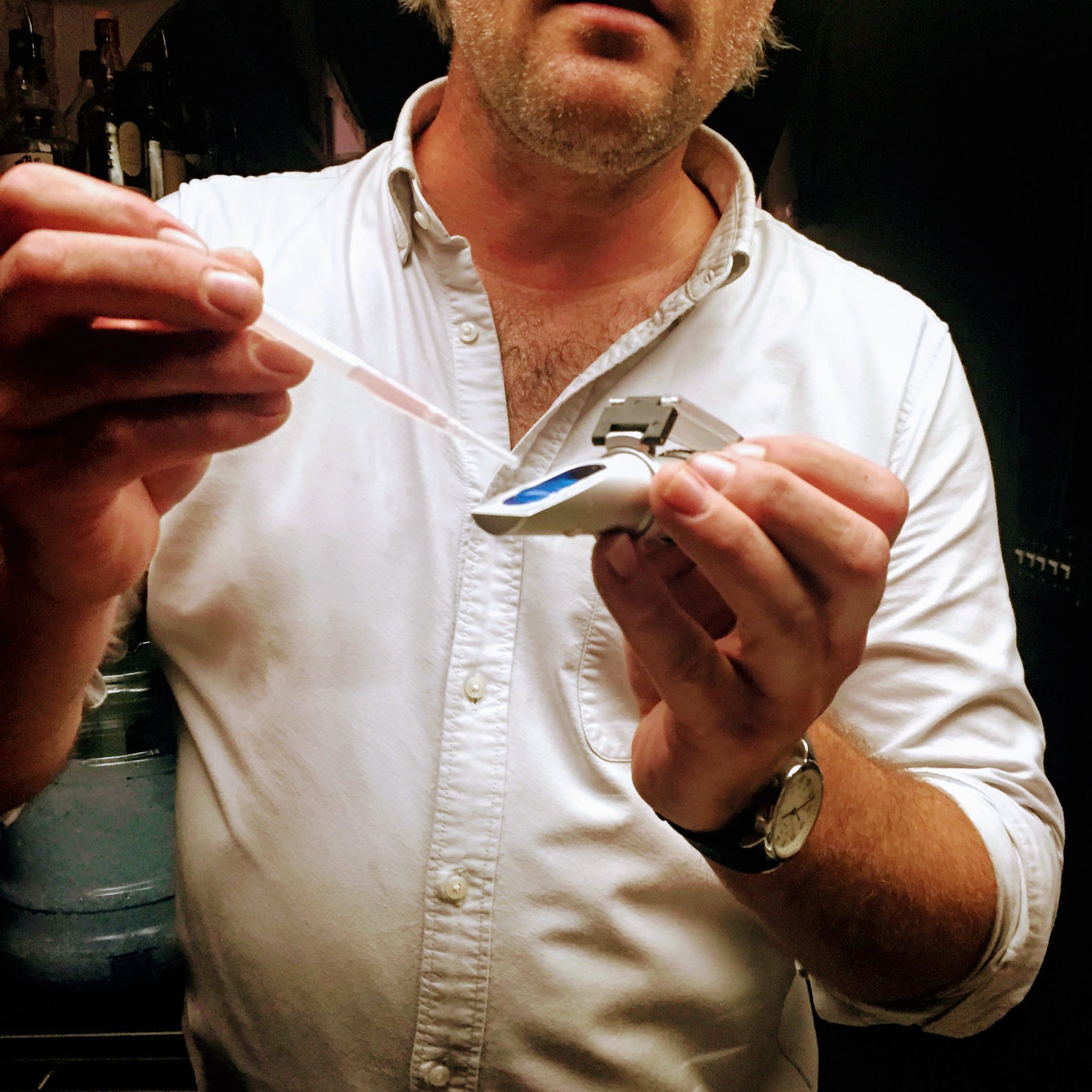
Okay, now the fun part. Take the pipette that came with your refractometer and grab a few drops of that cocktail of yours. Put it on the glass and close the slide cover.Hold the refractometer under a light and look through the lens. Read the total brix.

Now this is where you’ll make adjustments. Honestly, if the drink tastes balanced, it’s probably pretty damn close. If it’s not, well, maybe making balanced drinks isn’t your strong suit. That’s okay, we’ll fix that now.
Brix number too high? Just add a little water to the mix, a bit at a time, until you come in between 13 and 15 Brix. (Don’t forget to stir.) Brix number too low? Add some simple syrup, a little at a time, until you come in between 13 and 15 Brix. This is what you’ll see when you look through that refractometer, by the way:
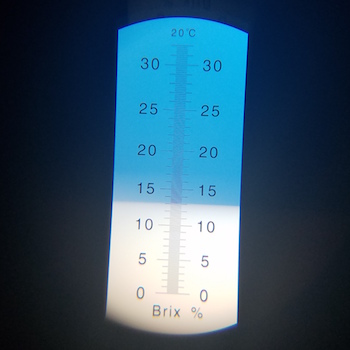
I like to chill the mixture overnight, if I can. Getting it as cold as possible means it will take less time to come to temperature once you pour it in the machine, but if you can’t do that, it won’t negatively affect the taste or texture of the drink, it’ll just take longer to coldify. Once you’re ready, pour it in the machine and turn the machine on. This takes a couple of hours, at least. But once it’s nice and cold, you will have a perfectly slushy cocktail, provided you got it between 13 and 15 Brix. Your drink will look like this and you will be something of a hero.
And that’s pretty much it! A few notes, just off the top of my head:
- Yes, I’m aware that straight vodka does come in between 13 and 15 Brix. Alcohol does register as sugar on the portable refractometer. Bear in mind that I’ve never tried dumping straight vodka into a slushie machine to see if it would slush. Someone please report back and let me know if it works.
- Sours are the best drinks to experiment with at first. So, Margaritas, Daiquiris, Sidecars, etc. They’re basically built to come in at the right Brix number already. Once you’ve gotten a feel for making slushy sours, then I would recommend experimenting with the trickier slushy drinks, like Manhattans, etc.
- I know lots of you have been wanting a slushy Negroni recipe. Sadly I no longer have my notes from the last time I did that a few years ago, but here is the version I make in a blender at home. Feel free to scale it up and adjust for Brix.
Have fun!!
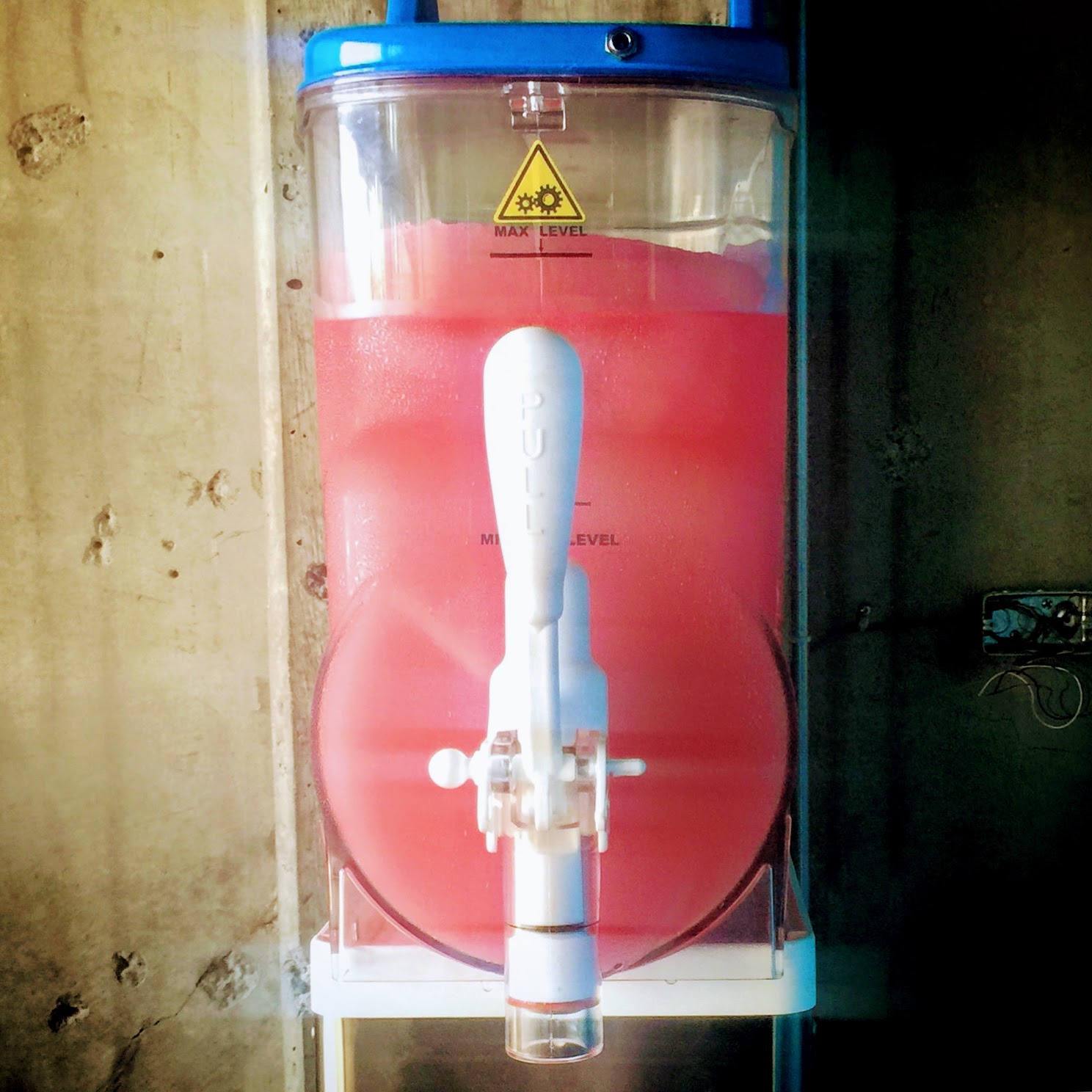


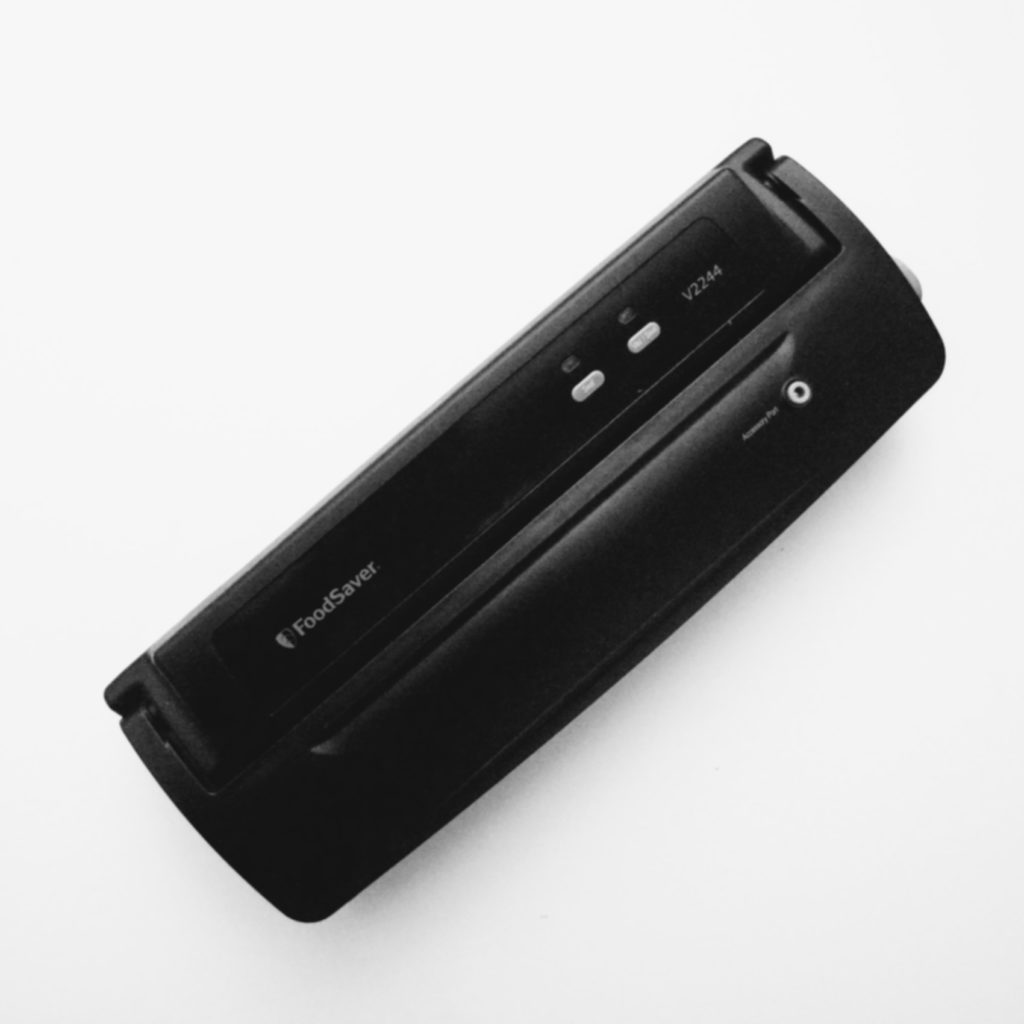
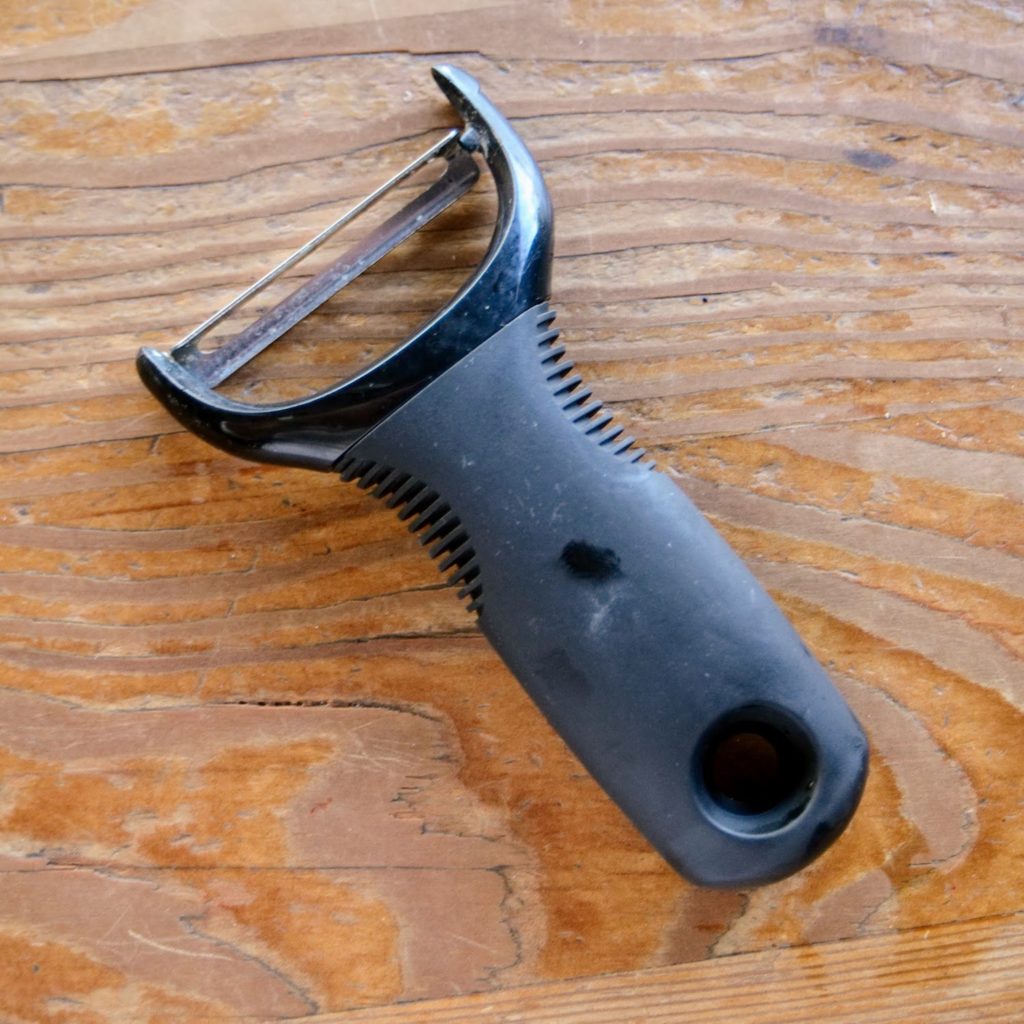
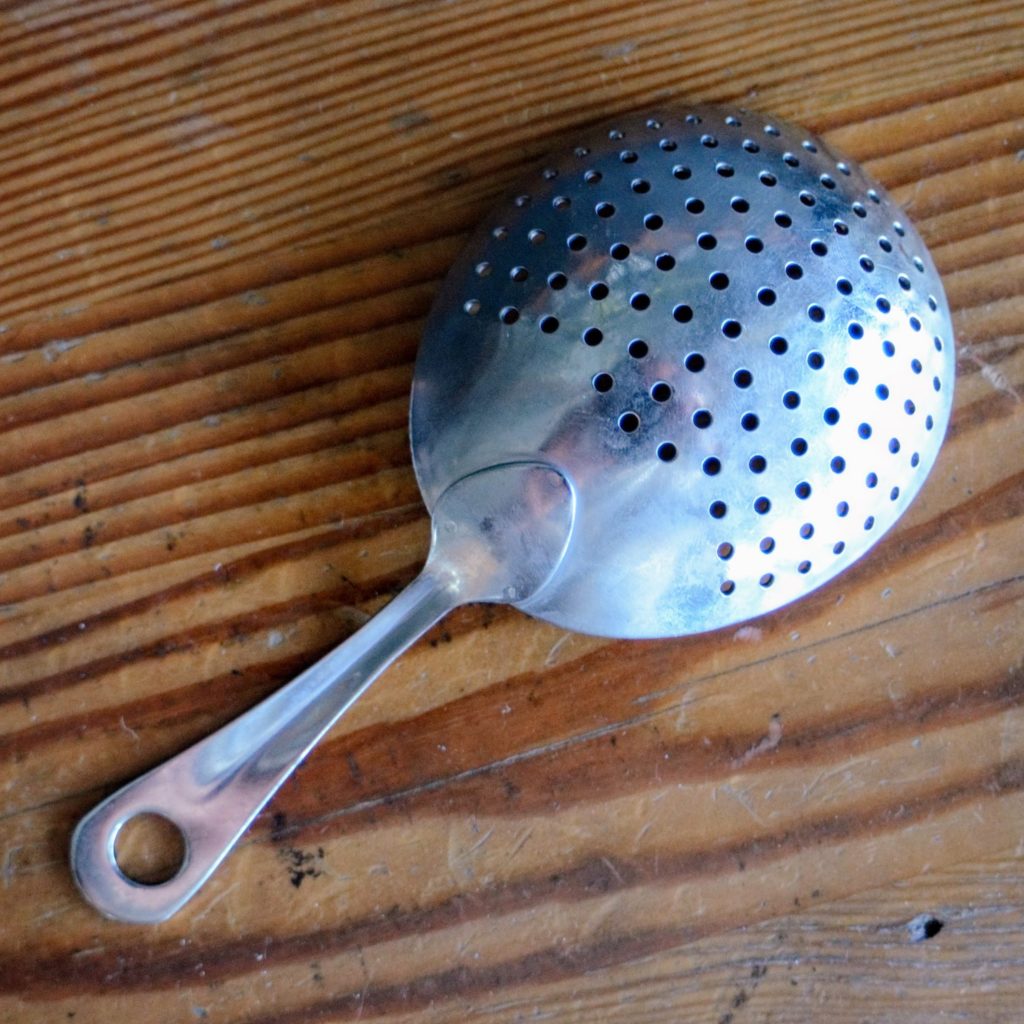
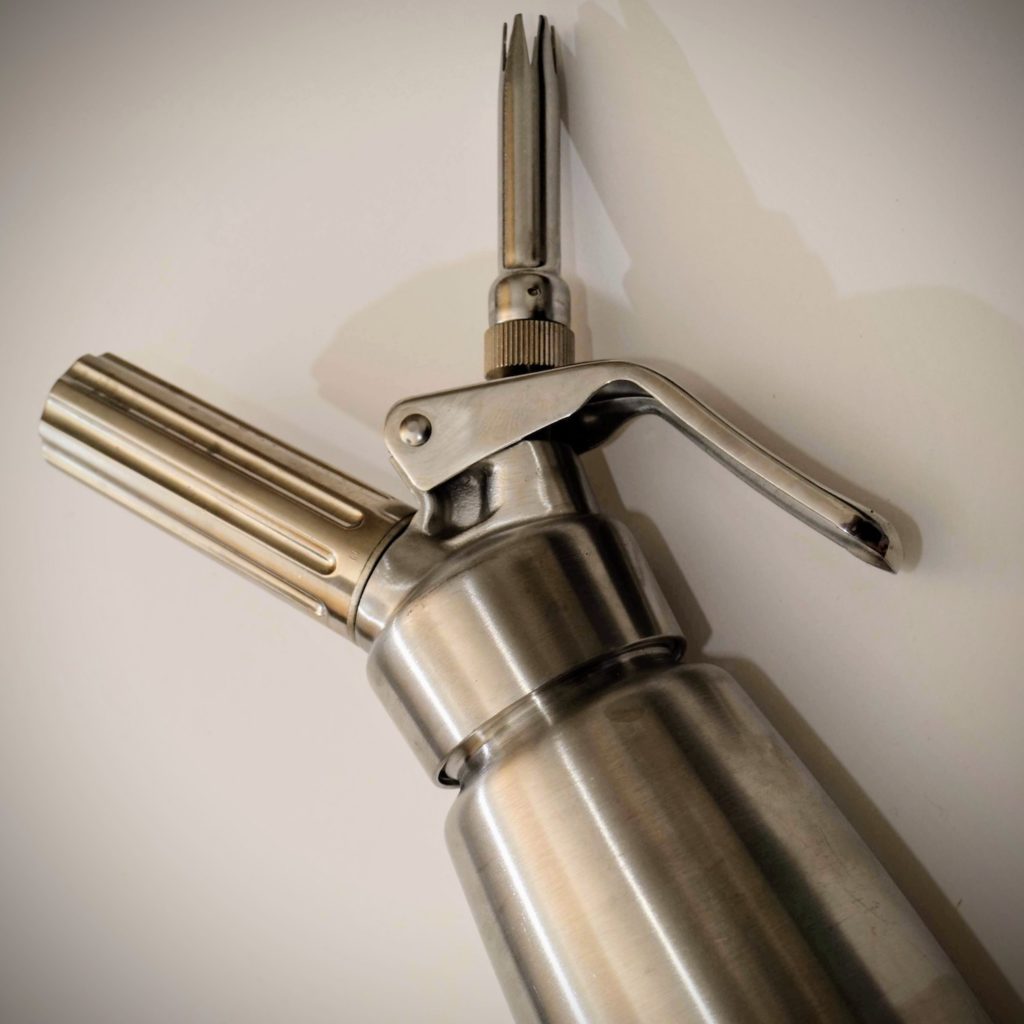

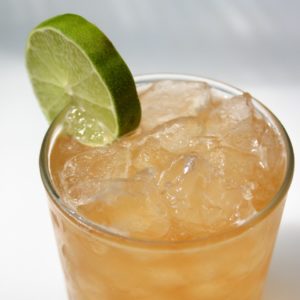
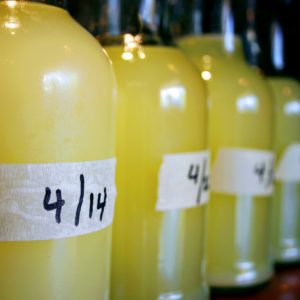
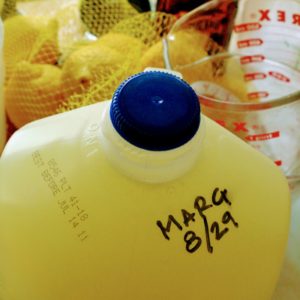

Matthew,
Is there anyway you could re-share that excel sheet? It looks like the link expired. Would be much appreciated, thank you in advance!
Jeffrey, your post saved my party and my mental health. I was going nuts trying to figure out what I was doing wrong with my brand new slush machine. It comes from China so the only customer support is by email. The owners manual was totally useless. My concoctions ended up being a frozen mess (lots of wasted alcohol) I bought the refractometer on Amazon and got it the next day. Presto!!! A perfect frozen cocktail. Thank you so much
So happy to hear that!
THank you for the article. Any tips or recipes that you are willing to share for a red wine slushy? I am trying to find one to surprise my wife when she gets back from her work trip.
Thanks,
Ron
Ron, I’d recommend starting with this recipe and instead of the three ounces of Negroni, substitute three ounces of red wine. That’s what I’d do, at least.
Hi! thank you for this article! Just what i needed. I am running a small winery in Upstate NY and need to make a wine slushy (1 red & 1 white). I can’t add alcohol beyond our own wine. Do you, or does anyone have a good recipe for this? I will be cranking these out all summer so i want to make sure to get it right. Thank you!
Hello guys. Amazing article, thank you so much.
The bar I manage recently acquired one of these and I wanna use it properly. The taste and texture is spot on but I’m always scared it freezes too much. Like there is a fair amount of ice outside of bowl where the liquid is.
I do check the Brix and it even mentions in the manual about it being 13-15 but I wanna know what can cause it freezing more. Is it lack of alcohol, or too much sugar?
I have a flavoured daiquiri and I know the Brix of that 100% but I’m not sure of the ABV target ? Like my Brix is correct (I use a digital refractometer for the non alcoholic measurements and the rest math) but it’s still freezing too much (if ice outside the bawl is considered too much) so I’m thinking I have my abv ratio off.
Lastly, with something like a pina colada, I don’t know the Brix of coco Lopez so if someone has a spec I will be eternally grateful. The one I have tastes amazing but I’m scared it’s freezing too much and it might brake the machine.
Many thanks!
These machines, especially the more inexpensive ones, all freeze up on the outside when they’re running, because that thin plastic bowl isn’t insulated. Your drink inside is below freezing (and perfectly slushy because you checked the brix and did it correctly), and the air outside has moisture in it. That moisture is condensing on the side of the machine and the below-freezing liquid inside is turning it into ice. If the texture is spot on and the drink inside is perfectly slushy, then it’s not going to seize up on you.
Slushie machines have two main parts: the tank and the core. The tank is where the liquid is stored, and the core is where the liquid is frozen. It is important to make sure the liquid is at the right temperature before you put it into the tank, because if it is too cold, it will not freeze. After you have put the liquid into the tank, the core needs to be frozen.
Hi,
I own a small coffee shop, bought a slush machine and I have been researching frozen cold brew recipes. I have purchased a frappe mix and I’m not confident in giving it a try. Wondering if any recipe exists or any coffee slush machine recipe at that. Thank you in advance for any help contributed.
I don’t personally have any recipes for that but I suggest you just attempt it. You are most likely not going to screw anything up by attempting it.
What a terrific resource, thank you!
Anyone have some math for serving size? I’m wondering how the volume changes from water to ice, so that I can calculate how much alcohol per glass once frozen, and/or what size glass I’d like, prior to the freeze. Maybe I’m missing something obvious, but that seems like a good target to include in my scribblings and spreadsheeting.
I am interested in making a Boston sour slushie but I have been unable to find any indication on if a cocktail with egg whites would react differently in a slush machine. Any thoughts?
If the whole point of adding egg whites to a cocktail is for a richer mouthfeel, I can’t see the point in using them in a slushie, which is already incredibly rich.
Question: I am working on making a slushie Paloma. I have the Brix set perfectly I was curious on the affect of adding salt in a slushie recipe. Obviously, ice and salt aren’t icy/melty friends, any thoughts or advice?
To be honest I’d probably recommend the salt as a garnish, rather than incorporating it into the drink.
I just got me a slush machine to have at the house for non alcoholic drinks. I bought some concentrates that mix 5 to 1 but not happy with consistency. It’s like tiny ice pebbles. I just mixed a batch 3 to 1 and get about 16 on the scale. Is the higher sugar content going to give me a smoother texture? Any advice is appreciated.
Yes, the higher sugar content should result in a smoother consistency.
I have a machine but am looking for some new simple recipes for it if you have any good ones please let me know
Good afternoon all!,
To start off ide like to say this is a brilliant website with LOTS of valuable information and a great comment section.
I have been trawling through the internet and struggling to find what I’m looking for so was very happy to find this site!!.
I’m looking for information on freshly made (non of this premade syrup horrible stuff) cocktail machine “slushies”.
Recipes/ratios… but also can I premake batches and keep them frozen? Will they keep the same consistency? how long will cocktails with lots of lime or fresh fruit stay “good for ” in the freezer .?
can i make a homemade syrup type batch to make it quicker in a rush?
I am currently living in England and planning on moving to Spain to open a bar in the coming weeks and think this could be a great side business. I’m just lacking some key points. I would be extremely grateful for any advice/hints/tricks or warnings!
many thanks for reading this!!
Brendan
Brendan – Yes you can totally pre-make fresh juice cocktails and freeze them! I’ve frozen my Margaritas by the Gallon many times and they taste great even a year later.
Have you ever done wine slushies? Should I just stick to the 13-15 rule?
I have! I just add enough simple syrup to get it to the 13-15 required for slush.
Hey Mark, were you able to solve the pale and non consistent cristals? I am having the same problem on a non-alcohol beverage application. Could you share??
If I use your gallon Margarita recipe in the slush machine do you add in any water? THe machine folks who I’ve rented from keep telling me I need to add water in 1st to create the right texture, but they are talking about people using their garbage sugar mix. I’m using all fresh limes & lemons (squeezing like a maniac!) Thanks!!!
I recently had great success making frozen negronis with a slushie machine using the following recipe that I cobbled together from this article and a comment on another article:
1.5 liters Campari
1.5 liters sweet vermouth
1.5 liters gin
1.5 liters water
1.5 liters orange juice (sugar = 0.10 g/mL)
0.5 liters bar syrup (sugar = 0.76 g/mL)
This looks great! Thank you for sharing!
I’m having trouble making a granita (frozen coffee) with no alcohol. I’ve been using a refractometer, but even with the Brix at 13-15, it goes pale within a few hours and the crystals dissolve quickly. It seems to be getting aerated.
Any tips for keeping the crystal size consistent and increasing shelf life? I tried blending in a tiny amount (.5%) of xanthan gum but it immediately separated upon freezing.
Thanks,
Mark
Not sure what you mean by it going pale and the crystals dissolving quickly – can you elaborate? Note that this technique is not for granita, but rather a smooth slushie.
can I make ice cappuccino with a slush machine?
I would imagine you could make anything you like!
What slushy machine do you recommend . I’m debating on ordering a machine from alibaba or if I should go thru a restaurant store. Does anyone have experience on purchasing from either sites
I don’t have one personally but I’d recommend going through a proper restaurant supply store.
Hey Jeffrey, thank you for this tutorial.
I know a slushie machine is a nice little tool to have but I always look at the price tag. Do you think this can be a good investment if you are not buying it to use in a shop? I’m also thinking of getting a freezer but I’m sure I can make a slushy drink with that. What do you think?
I hardly think I’d call it an investment if you’re just using it home, but it could definitely be a fun little toy to have!
Sure, here’s one I did for a recent cocktail. You should be able to download it and use it yourself. With a little Excel-fu you could switch it match cocktails with other ingredients, this is pretty much basically a sour with fruit puree.
I like generally around 13-15% sugar and around 1% acid. (This measures that too, lemon and lime average around 6%. You can get an acid titration test kit for cheap from a homebrew store if you want to measure other purees but I usually just Google the titratable acidity of whatever fruit and assume it’s close enough.)
I do small batch scaling on the right and the whole scaling on the bottom because I might make 20 gallons at a time and have to break it down into several buckets. The bottom part is mostly for purposes of my shopping list.
Hope this helps.
https://1drv.ms/x/s!AoMxtSMowPvuwEGiuIFzvKZYPRcR
Thank you, Matthew! This is incredibly helpful!
Matthew! This is incredible information. I just stumbled upon this as I am researching into doing frozen cocktails for my bar program. I downloaded your spreadsheet and have some questions in regards to the breakdown. Would there be a way to connect with you and pick your brain on the subject?
This is wrong because both alcohol and sugar refract light. It works only by coincidence, because it just so happens that a palatable drink is right around the slush range. I would say that if you got better at making them, it was more from experience than use of a refractometer because you are using the refractometer in a way that can not produce reliable results.
A refractometer doesn’t measure sugar. It measures refraction. And then you use the refraction to figure out the amount of sugar because there is a known relationship. Instead of displaying the index of refraction on the refractometer, it’s marked as percent sugar (brix) because that’s what you need to know.
The best analogy I can give is your car’s odometer. Your car’s odometer shows you miles, but it doesn’t actually measure miles. It measure’s a wheel’s rotation. But it knows x rotations = 1 mile, and you don’t give a shit about rotations. So the meter shows you miles. However if your car’s wheels are rotating without you moving (for instance your car is on rollers for an e-check) you get FUD from the odometer because what it’s actually measuring isn’t what it’s displaying.
Refractometers work the same. There are refractometers for other things, that are the exact same device but with different markings to show you different things for different refractive indexes. An alcohol refractometer might be the exact same as that sugar one, but have markings for ABV instead.
The problem is a refractometer does not work properly when there are two refractive substances, because they both refract light differently. That 13 brix you’re seeing isn’t actually 13 brix. It’s more like “if there were just sugar in here, the refractive index would indicate 13 brix” But there isn’t just sugar. Worse yet, it’s really hard to establish any linear relationship between them. There are a million different combinations of ABV and brix that might make your refractometer say “15 brix” and many of them would not form a slush.
(Also no, vodka would not slush in one of those machines. If something won’t turn to slush in your freezer, it won’t there because they aren’t colder. You’d have to get much lower temp, like with dry ice, to get it to slush. Vodka has no sugar, it just apparently has the same refractive index as a 13% sugar solution. That’s just coincidence.)
If you want to actually measure the brix of your cocktail, the easiest way is to use a spreadsheet. Use the refractometer to take anything that has sugar in it (fruit puree, for instance) and find it’s brix. Water, liquor, etc. have no sugar. (Liqueurs are tricky because they have sugar and alcohol, but you can Google the brix of most of them, or look them up in Liquid Intelligence, and of course they say the ABV on the bottle. You cannot find their brix via refractometer, even given the ABV, because the refractive index doesn’t change in a predictable way.)
Take a slushy from 7-11 and put it in the refractometer and you’ll see it’s actually about 12 brix. This is actually just a hair more than Coke and Pepsi, which is why they slush up nicely with a tiny amount of sugar added. You taste the sugar less when they’re cold, so it tastes about the same.
You actually only need about 12% brix to slush. (I’d not be surprised if slushies have some hydrocolloids for texture but if they do I don’t know what.) However you could easily go as high as 20% sugar and still get a slush. (Sorbet has about 30% sugar, for comparison.)
Ethanol also lowers the freezing point, so by adding liquor you can dial down the sugar. If you’re getting your drink coming out too loose, you’ve probably got too much liquor. (If it’s too much sugar it will be unpalatable.) If it’s too solid, you can dial up the liquor and/or sugar.
Again, the best way is to design in a spreadsheet. I’m happy to share mine.
This is super helpful and makes a ton of sense. I think we’d all love to see that spreadsheet if you wouldn’t mind sharing it!
Is it just me or has anyone noticed that if you put liquor in a slushy machine the alcohol evaporates over time. Am I crazy or is this actually happening?
I am absolutely, 100% positive that none of your machines are that intelligent that it will measure your electrical circuit and then as a nice little machine only use whatever is left over so that the fuse won’t burn up, or break off the power if you have modern ones.
Good Froze recipe
1 750 ml bottle hearty, bold rosé (such as a Pinot Noir or Merlot rosé)
½ cup sugar
8 ounces strawberries, hulled, quartered
2½ ounces fresh lemon juice
Jackie,
I’ve been working on an orange creamsicle slushie for a friend’s wedding. I plan on adding moonshine to it:) This weekend i made this recipe for an Orange Julius, http://girlgonegrits.blogspot.com/2012/01/give-me-orange-julius.html?m=1, it came out awesome! I was adding vodka to it after i poured it, because wife and kids were drinking it also. I ended up multiplying everything by 16, and added 1/2 gallon of water. I initially added a quart of water, but added more because of the sweetness. This is a winner. BTW I’m using a Ugolini NHT 2UL.
@ Kern:
I did a frose experiment a few months back. For a 750 ml bottle of cheap $10 rose, 50 grams of caster sugar should dissolve right in the cold wine. I didn’t test it in a slush machine, but it was pretty good when I tried a scaled down sample (150 ml wine w/ 5 gm caster sugar, mixed up and left to freeze).
This should be fine in a machine but i haven’t tested it, so if it gets too hard, make sure you have some simple syrup on hand to adjust it.
On the other hand I avoided simple in this recipe because it kept watering down the slush, so you might want to avoid the syrup.
Looking for a recipe for froze (Frozen Rose Wine) in a margarita machine… anyone have a good one? Can I just use neutral base slushie mix, and add Rose Wine? (Or for that matter champagne or other wines) ?
I am wanting to try something different for a family reunion.
I am wanting to make a creamsicle slushie with alcahol. Has anyone tried to use ice cream or whipping cream in their slushie recipe?
I have a commercial slushie machine.
Any comments????
Thanks….
Considering the bunn model ultra 2 34000 for margaritas and daiquiris made with fresh citrus and standard proof liquor, anyone have experience with this model for these drinks?
https://www.webstaurantstore.com/bunn-34000-0081-ultra-2-hp-high-performance-black-and-stainless-steel-double-3-gallon-pourover-slushy-granita-frozen-drink-machine-120v/234340000081.html?utm_source=Google&utm_medium=cpc&utm_campaign=GoogleShopping&gclid=Cj0KEQjw9r7JBRCj37PlltTskaMBEiQAKTzTfGbYkHCv8S5Tr06PhPjAdfZvnSdwM8XEI6RL6BkoaJMaApyU8P8HAQ
Scott,
I will agree that circuit load (how many things are using power)but will add that it is not the amp draw that causes the inductive compressor efficiency degradation. The culprit is the reduction in voltage (line pressure. Think of it as a the flow of water coming out of a hose. if a Y splitter is attached and another hose is opened, you get a reduction in pressure and subsequently flow. The compressor need this pressure to operate efficiently and come up to its happy speed. The size of your wiring, and the length from the main box all go in to calculating the allowable voltage drop for a given amp draw. The industry standard is no more than 3% drop.
Hi I have a 2 barrell plastic machine and want to use it at events like school fairs etc. how do I keep the mixture frozen when it is constantly being used? I’m thinking that we have to keep replacing the top 10% as we go or something but any tips? Should we keep the temperature up higher than usual when we have high usage days?
Seth,
With all due respect, but that’s the biggest load of bollox I’ve ever heard.
I am absolutely, 100% positive that none of your machines are that intelligent that it will measure your electrical circuit and then as a nice little machine only use whatever is left over so that the fuse won’t burn up, or break off the power if you have modern ones.
The compressor will use whatever amperage it needs, without any concern for anything else. If that means that there will be more load on the fuse than the fuse can handle (because you have other stuff connected to that same circuit), it’ll just go off and your machine will go dead… At least until you flick that breaker switch again, or replace the fuse.
Stop your mansplaining.
Hi, a few comments and a question:
To make a recipe, ive set up a spreadhseet that tells you brix and abv, the rest is up to your imagination.
I don’t use refractometer on the final mix–i do it before i add alchohol. If its near my “pre alc brix estimate” i add alc, if not i adjust.
I’ve read several places that most hard liquors have absolutely no sugar, and I have created recipes under that assumption which have worked well.
To test a recipe, i assemble a small version (using graduated cylinder and ml to get high accuracy), then throw it in a plastic sandwich bag. After freezing it, rub it around in your hands under running water and pour it into a glass. It won’t be a perfect texture but veey good.
Question…I use a range of 12 to 16 brix (i target 12.5). The danger of going lower is that your machine will get damaged from overfreezzing. I do wonder, however, doesn’t the fact that I’m using alchohol give me more leeway for brix? I figure i might be able to go lower on brix in proportion to much alc i add, without damaging the machine or consistency. I ask bc sometimes drinks taste too sweet and i want to use less. Thanks.
Any chance you’d be willing to share that spreadsheet?
Hello,
I just wanted to chime in on this as I used to run a business which rented these out to people. First thing I wanted to yell and holler at you over and over is that the number one thing you need to do to get these machines to work right has nothing to do with what goes into them, it concerns the power.
YOU NEED A DEDICATED 15 AMP CIRCUIT OR THE MACHINE’S COMPRESSOR WILL NOT TURN ON ALL THE WAY AND IT WILL NOT GET COLD.
I had a hundred and fifty of these things of various makes and models and the power issue is always, ALWAYS the problem. Well, 99% of the time. What that means is, in your breaker box, you have all the switches. Each switch controls certain receptacles, and on the switch with this machine, you need to make sure its the only thing plugged in. The compressor needs something like 12.9 amps to fully activate, so if you have a music system running with a few lights on the same circuit, the compressor will not be able to fully activate. Now, once it does kick on, (you can hear it like you can on any fridge, its louder when its on) it reduces the power draw a few amps. This can lead to inconsistent performance. Its why your home fridge has its own switch on the breaker board.
As far as buying one, they are quite pricy from the factory, but regional sellers carry brands from Taylor or Bunn or Ugolini (Italian and often rebranded in the states) and consistently try and sell people a mini-margarita machine franchise and they constantly go out of business. They are like carpet cleaning businesses. So often you can find them used. We would routinely buy out these guys as they started up, underpriced, then went out of business, and they usually bought brand new machines, so we got a good price. But be warned, new these things are well over a grand for a single tank machine.
One last thing is the recharge rate- there is a certain amount of drinks per hour each machine can produce, given proper power. Pre chilling your batches is great- but understand that your machine has a limit beyond which it just wont go. The machine pictured in the article is a multi tank but still considered low volume- there are some that are all stainless steel and have much more powerful compressors and can double the volume of those plastic tank style machines. (I think Crothco was my favorite of these, or older saniserves) If you find these used, older is better, and without any lcd parts is best.
Anyways, hope this helps, I had all this otherwise useless information but now I have purged it. Good luck!
I have suffered a lot of hours coming up with various ‘fresh’ slush cocktails. Then I came across Kelvin Slush Co.! They make a variety of bases that are actually really great and easy to work with. The service is amazing and love trading feedback to come up with recipes for cocktails. I recommend giving them a try to anyone who is putting a slush machine on as a permanent fixture in their bar.
http://kelvinslush.com
Just used your gallon margarita recipe for my slushie machine and it’s freezing as I type. The suspenseful wait for the texture of the mixture is the worst part.
How much ice do you include in the blender for the frozen negronis you give the recipe for at the bottom?
I have a feeling the Brix number you’re using is sort of a target and uses a lot of assumptions as far as the other ingredients being used (80 proof spirit, lemon or lime juice). A refractometer is consistent on its own, but alcohol throws off this measurement as light refracts differently through alcohol when compared with water. Same goes for cloudy ingredients, like lime juice. That being said, I think it’s something to consider when you’re making an NA slushy or something that doesn’t have citrus. When drastic changes are made to a 2:1:1 recipe, one might have to go back to the trial and error method.
Would the same Brix principle hold true for blended drinks? In other words, if I blended up a cocktail with ice cubes, then adjusted the Brix to the proper range and reblended, would it keep the drink from quickly “separating” in the glass? Don’t have a refractrometer yet 😉
For the record: Vodka will slush. But only if it doesn’t have glycerin added. And is under 90 proof. And I figured this out from keeping it on dry ice for a bit. I’m useless.
And they are daiquiri machines here in Louisiana. Just a little local cultural difference that makes us awesome. Come to the drive through and get a few gallons for a party! Life is good down here somethings, for sure!
Jeff,
Any other recipe suggestions- like perhaps a slushie rendition of a vieux carre or a boulevardier?
V/R,
Mike
Wanna guest bartend in our Daiquiri machine next week?
dear friend, we are in tune.
I am using a similar device from a couple of years ago.
It is helpful in the summer, fresh cocktails and fast in the restaurant.
Best Regards
Fede
Hey Jeff, so Fresh citrus won’t hurt the metal cylinder that freezes the drink? I’ve been told by numerous people that the acidity of fresh juices could effect it over time, that’s the only reason Ive never tried to make a fresh margarita or daiquiri in my slush machine. I can’t stand the neon green syrup that batches frozen margarita.
Josh – Fresh juice and neon green mix both rely on citric acid for their flavor, so there’s no more inherent danger in using fresh juice. Squeeze away, that steel cylinder will be just fine.
You are the man Jeffrey!
BTW, any suggestions on buying a slushy machine?
Gregory – I’ve never purchased one but I’ll do some research after work tonight and try to pop a link in the text!